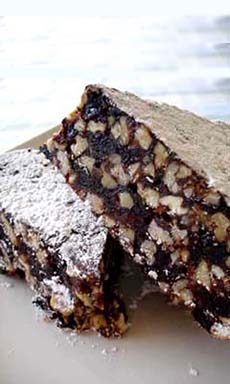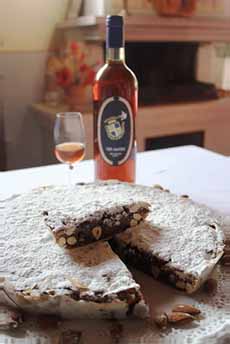Panforte Christmas Bread & A Panforte Ice Cream Recipe
|
|
If you receive—or pick up—a panforte for Christmas, there’s lots you can do with it. This article is all about panforte, a medieval Christmas bread that’s now enjoyed year-round as a dessert. Although always referred to as “bread,” it’s a sweet bread or cake, like banana bread, zucchini bread, and so many others. It’s a relative of English fruitcake—dense and packed with fruits and nuts—but with a different flavor profile. If you want to make panforte from scratch, here’s Chef David’s Lebovitz’s recipe (photo #1). > Also below, the different types of panforte. > Also below, how to serve panforte and wine pairings. > Also below, our recipe for panforte ice cream. Delicious! > The difference between panettone and pandoro, two better-known Italian Christmas breads. > The different types of bread: a photo glossary. > The different types of cake: a photo glossary. Panforte, a dense, sweet, and spicy Christmas dessert bread, originated in Siena, a city in the Tuscany region of Italy, in the 12th or 13th century. The name means “strong bread” (pan forte), for its dense texture and spicy flavors. The dessert was originally baked by nuns, monks, and apothecaries. It was considered both a delicacy and a medicinal item (now there’s an excuse for eating cake!). Too expensive to be eaten by the nuns and monks themselves, it was given as an offering to religious institutions or gifted to clergy and nobles, particularly during festivals and special occasions. Wealthy families and religious institutions funded the use of exotic spices imported from the East, making the dessert as a luxury item (source: ChatGPT, 2024-12-22). Only the rich could afford the exotic imported spices. The high concentration of nuts and dried fruits added to the expense. Why a medicinal item? The spices—cinnamon, coriander, and nutmeg, for example—were highly valued for their perceived medicinal properties. Honey was also valued for its therapeutic qualities*. It was initially also called panpepato (peppered bread) reflecting the strong presence of costly black pepper in early recipes. But its origins date back to a simpler, affordable honey and fruit sweet bread made in local monasteries, called panmelato, “honeyed bread.” Panmelato was: Sooner or later, someone thought to substitute candied fruits for the fresh ones, creating a dessert with a long shelf life year-round. The evolution from panmelato to spiced panforte is attributed to the spice trade boom in the Middle Ages, when Siena became an important trading center. Now a dense mixture of almonds and candied fruit, still sweetened with honey but richly flavored with spices, it was originally called panpepato con miele (peppered [spiced] bread with honey). Still baked by nuns, it became a traditional Christmas bread. The delightful recipe spread beyond Tuscany. Panforte nero. The original medieval version, panforte nero (black panforte—photos #1 and #9) is dark in color due to spices and black pepper, which also give it an intense flavor profile. The top is dusted with black pepper rather than the sugar used on panforte bianco (white panforte), for even more of a spicy kick. By the 18th century, panforte was exported across Europe, contributing to Siena’s economy. Its long shelf life made it perfect for traveling, and the Siena bakers guild carefully guarded the original recipes, helping maintain a monopoly. Panforte al cioccolato. Another century later, in 1820, panforte al cioccolato (chocolate panforte—photo #7), also known as panforte delle dame (panforte for the ladies) was created by Giovanni Parenti, the founder of the first panforte factory. The ingredients include cocoa, blanched almonds, candied melon, and figs or dates, covered with a thin layer of chocolate fondant [source]. Panforte Margherita. In 1879, panforte Margherita (photos #2, #6, and #11) was created to celebrate a visit to Siena by Italy’s Queen Margherita (photo #3), who arrived in the summer to watch the Palio di Siena horse race. (The pizza we now know as Margherita was renamed in her honor when she visited Naples in June 1889—see the footnote** [source].) A lighter, milder version, panforte Margherita uses vanilla instead of some of the stronger spices, and is dusted with powdered sugar. Today it’s also called panforte bianco (white panforte). This less intense version became so popular that it’s now the preferred panforte of many, with panforte nero, the original, in second place [source: Claude AI, 2024-12-22]. Panforte fiorito. Another, sweeter variation followed: panforte fiorito (flowered panforte)—photos #4 and #5. Flower essences in the batter and a layer of marzipan on top. There are also regional variations from other parts of Tuscany, each with slight differences in spice blends or fruit-to-nut ratios. And other countries add their own spines. For example, we really enjoy the modern tropical panforte (photo #8), which appears to have been developed in the U.S. It has a slightly different mix of fruits: dried coconut, pineapple, and mangoes, plus macadamia nuts, candied ginger and spices. We find this combination of flavors to be pretty exciting. Panforte fichi e noci (figs and nuts) is an alternative version of the classic panforte nero. It replaces the almonds with walnuts, and eschews other fruits in favor of dried figs. Panforte is now enjoyed year-round. In modern times, some bakers are inspired to create new versions, incorporating: It will cost more, but look for artisanal producers. They still follow traditional methods, making panforte by hand using age-old recipes. Rich and dense, panforte is typically served in thin slices. We personally serve it in a non-traditional way, with whipped cream or ice cream (vanilla or rum raisin). In Siena, they often serve it with a small glass of vin santo, a sweet Tuscan dessert wine that complements the spicy flavors. You can also pair other Italian dessert wines† and sparklers such as Asti Spumante, Brachetto d’Acqui, Moscato d’Asti, Prosecco, and sparkling Lambrusco. In addition to its place as part of Christmas seasonal fare, it can be served year-round: At room temperature, which is how it best expresses its flavors Like England’s Christmas puddings, panforte is known for its exceptional shelf-stability. If properly stored, it can last 3-6 months, sometimes even longer. We were inspired by this recipe from Chef David Lebovitz to make panforte ice cream (photo #10). His recipe consists largely of the candied fruits he had left over from making actual panforte. We took a different approach, using most of the classic panforte ingredients. 1. START with this honey ice cream recipe. 2. SELECT the inclusions and proportions you prefer. We tried to follow the classic ingredients as much as possible, with some variations. |
|
|
________________ *The medical properties of honey: antioxidants, cough relief, gastroenteritis, vitamins and minerals including (ascorbic acid, calcium, copper, iron, magnesium, manganese, niacin, pantothenic acid (vitamin B5), phosphorus, potassium, riboflavin, and zinc. Honey also has been used for millennia to heal burns and wounds, due to its antibacterial and anti-inflammatory properties. And long before there were better treatments, honey was used for neurological diseases: as an antidepressant/anti-anxiety treatment and an anti-convulsant. **The origin of the Margherita pizza: While the name pizza Margherita may have been popularized because of the Queen’s visit to Naples in 1889, a pizza made with the same toppings (mozzarella, tomato, basil) was already present there. In 1849 Emanuele Rocco recorded a pizza with those toppings. The mozzarella was thinly sliced, and arranged in a flower shape over the tomato sauce, along with the basil leaves. Confusingly, this may be the real origin of the name pizza Margherita, since margherita is the Italian word for daisy [source]. †Italian dessert wines include: Barolo Chinato, Moscadello di Montalcino, Moscato Bianco passito, Moscato Rosa/Rosenmuskateller passito, Ramandolo, Recioto della Valpolicella, Vin Santo (photo #11), and Zibibbo/Moscato di Alessandria/Moscato di Pantelleria. Passito is an Italian term that refers to a sweet dessert wine made from dried grapes. ††The vin santo grape blend diffesr according to location. Trebbiano Toscano from Tuscany (photo #11) combines two grapes, Malvasia Bianca Lunga and Trebbiano. Malvasia provides body, texture, and perfume, while Trebbiano adds acidity. Vin santo is also produced in other Italian regions, including Carmignano, Rufina, Trentino, Umbria, and Veneto. These other regions make vin santo with their own local grapes. For example, Veneto producers use Garganega grapes, while Trentino producers use Nosiola grapes. ‡The difference between candied and crystallized ginger: Both begin with fresh ginger root. Candied ginger is boiled in a sugar syrup until tender and chewy. It is softer and juicier than crystallized ginger. It needs to be stored in syrup to prevent drying out. It can be used in baking, confectionery, glazes and marinades, salads and slaws, chutneys, and beverages, from tea to cocktails to mulled cider or wine. Crystallized ginger is dried after being cooked in sugar syrup, then coated with granulated sugar. It is firm and crunchy with a chewy interior, and can be enjoyed as a spicy candy, in baked goods, or as a garnish for desserts. It can be stored as is. CHECK OUT WHAT’S HAPPENING ON OUR HOME PAGE, THENIBBLE.COM. |
||













